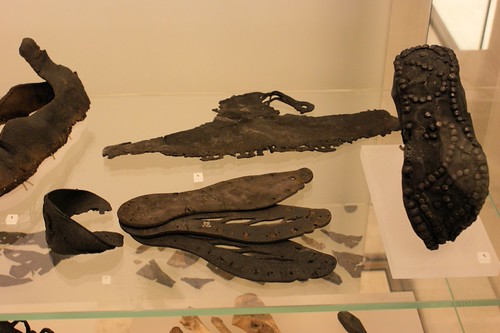Finally. Here’s the long promised skeletal materials gallery from our NMS photos. Leather finds photos are in another post, and I’ve already done the leatherworker’s toolkit elsewhere. Click on the photos in the gallery them to ennoble if you want a closer view.
The full set of photos contain lots of stone and metalworking as well.
Stone, bronze and iron age

Burnt stones and flint, leatherworker’s rubbing bone fragments and pebbles. Family cist grave, Patrickholm, 2100BC-1750BC

Bone axe-headed pins. Orkneys, AD0-600

Weaving comb and leather fragments. The triangular piece looks like it might have been from a tent. Newstead, 100-175AD

Bone shuttles, Dun Scurrival and Elsay, horn(?) weaving tablets, Burrian, Jarlshof, Keill, Tain, Keiss 200BC-AD200

Bone dice, Newstead and Sty Wick Bay AD1-200

Broxmouth, Burgar, Hillswick, Howmae, Newstead and Thrumster, 200BC-AD400

Bone, metal and wooden British leatherworking tools. Awls from Ruberslaw, Burrian, Druimvargie Cave, Foshigarry, Knop of Howar, MacArthur Cave, Skara Brae, Torran Dubh, Buiston and Newstead. 8500BC-900AD
Needles from Hillhead, West Grange of Conon and Laws of Monifieth. 300BC-800AD.

200BC-AD800

Making antler combs 200BC-AD800

Comb blanks and flat plates 200BC-AD800

Bone pins, Kerrera, Buiston, Burrian, Jarlshof and North Uist, Covesea. AD500-1100

Bone pins, Skara Brae, Broxmouth, Jarlshof, Roughout.

Bone pins, AD600-1000 Burrian, Foshigarry, Jarlshof

Bone combs, pendants, handles and belt sliders, AD500-1100. H.KL3

Bone needle cases, Freswick and Vallay AD800-1100
Bronze needles and bodkins, Balevullin, Freswick, Newstead, Swandro and Traprain Law 200BC-AD1000
Bronze shears, Loch Erribol, AD1-200.

Pin beaters used in weaving. A’Cheardach Mhor, Dunbar and Jarlshof. 200BC-AD400

Bone needles and bodkins. A’Cheardach Mohr, Burrian, Foshigarrt, Freswick, Jarlshof, Keiss & Newstead. 200BC-AD1000

I think this little fellow is walrus ivory, a game piece in the shape of a cowled figure from Mail in the Orkneys, AD750-800. He looks similar to the hooded figures shown on the Pictish standing stones of the period.

Bone comb from a pagan male Viking grave from a Viking and native cemetery on Orkney. Eighth-ninth century. The museum shows the grave as excavated.

Bone Mattock, knife and tool handles. Foshigarry, Vallay, Burrian, Cairston and Stromness. 200BC-AD800
Medieval

Antler comb from a woman’s grave, Cnip, c. AD1000.

Bone needle case with remains of metal needles. Woman’s grave, Cnip, c. AD1000.

Bonework debris, Bac Mhic Connain, Borough of Biordsay, Foshigarry, Gurness, Jarlshof and Westray, 4000BC-AD1500

Knight from the Isle of Lewis chess set. This one’s a token effort. I’ll cover all the pieces in another post as I’ve been chasing them around the various musea that have them. Walrus Ivory, found in Uig, Lewis in 1831. Other pieces are in the British Museum. H.NS19023, H.NS 25-9.

Leather belt pieces and bone awls with off-cuts from leatherworking, from Fast Castle, Berwickshire.
Early Modern

Powder horn belonging to James Graham, 1st Marquess of Montrose (25 October 1612 – 21 May 1650), his arms are engraved in the silver base plate.




















































